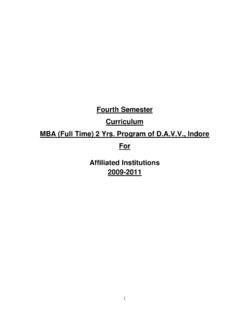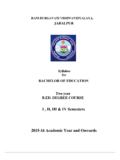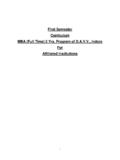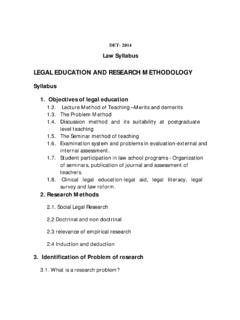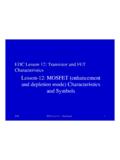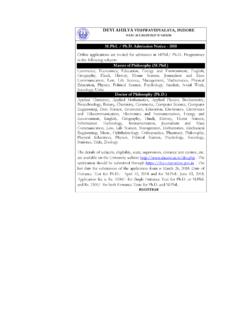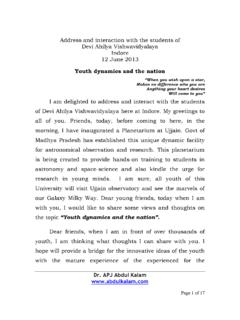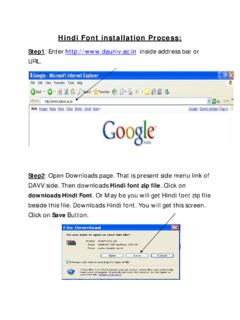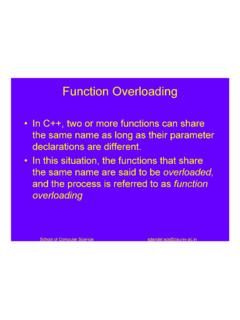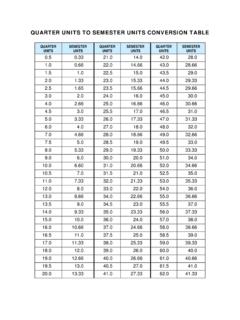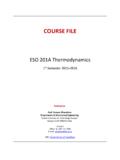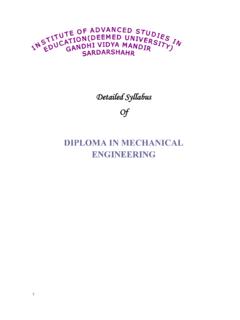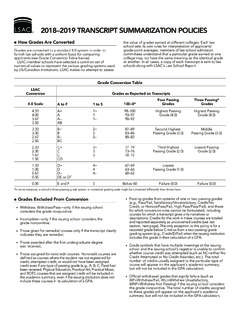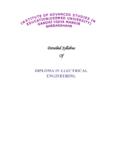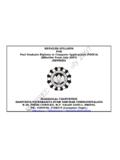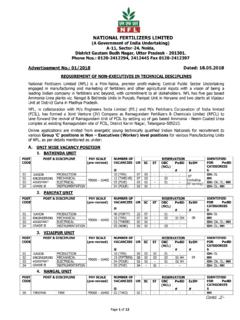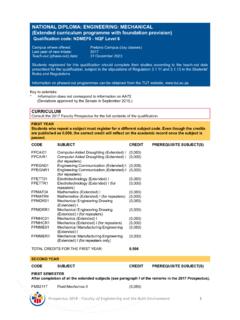Transcription of Detailed Syllabus of B.Sc.(Computer Science) , B. Sc ...
1 1 NEW Detailed Syllabus of (Computer Science) , B. Sc.(Computer Maintenance) and (IT) Effective From July 2010 TOTAL PAGES = 20 2 SEMESTER SYSTEM Syllabus FOR B Sc(CS) , B Sc(IT) AND B Sc(C. MAINT.) Effective since July 2010 Effective From Session 2010-2011 CLASS -------- / SEMESTER (CS) / (CMAIN.) (IT) CCE 30 % MIN. MARKS TERM END EXAM 70% MIN. MARKS TOTAL 100% MIN. MARKS FIRST SEM. CS-101 PC SOFTW ARE CS-101 PC SOFTW ARE 15 5 35 12 50 17 CS-102 COMPUTER FUNDAMENTALS CS-102 COMPUTER FUNDAMENTALS 15 5 35 12 50 17 CS-101P - PRACTICAL ON W INDOWS, MS- OFFICE, AND INTERNET CS-101P - PRACTICAL ON W INDOWS, MS- OFFICE, AND INTERNET ---- ---- ---- ---- 50 17 SECOND SEM.
2 CS-201 PROGRAMMING AND PROBLEM SOLVING THROUGH C LANGUAGE CS-201 PROGRAMMING AND PROBLEM SOLVING THROUGH C LANGUAGE 15 5 35 12 50 17 CS-202 COMPUTER ORGANISATION CS-202 COMPUTER ORGANISATION 15 5 35 12 50 17 NA CS-203 INTRODUCTION TO INFORMATION SYSTEM 15 5 35 12 50 17 CS-201P - PRACTICAL ON C PROGRAMMING CS-201P - PRACTICAL ON C PROGRAMMING ---- ---- ---- ---- 50 17 Effective From Session 2011-2012 THIRD SEM. ( FOR HONS.)---- CS-301 DATA STRUCTURE USING C++ CS-301 DATA STRUCTURE USING C++ 15 5 35 12 50 17 CS-302 DBMS FUNDAMENTALS CS-302 DBMS FUNDAMENTALS 15 5 35 12 50 17 CS-301P PRACTICAL ON DATA STRUCTURE AND DBMS CS-301P PRACTICAL ON DATA STRUCTURE AND DBMS ---- ---- ---- ---- 50 17 CS-303 SYSTEMS PROGRAMMING NA 15 5 35 12 50 17 FOURTH SEM.
3 ( FOR HONS.)----- CS-401 OPERATING SYSTEM USING LINUX CS-401 OPERATING SYSTEM USING LINUX 15 5 35 12 50 17 CS-402 SYSTEM ANALYSIS & DESIGN CS-402 SYSTEM ANALYSIS & DESIGN 15 5 35 12 50 17 NA CS-403 INFORMATION TECHNOLOGY AND ITS APPLICATION 15 5 35 12 50 17 CS-401P PRACTICAL ON LINUX CS-401P PRACTICAL ON LINUX ---- ---- ---- ---- 50 17 CS-404 COMPUTING AND ITS APPLICATIONS 15 5 35 12 50 17 PS :- CCE ----- CONTINUOUS COMPREHENSIVE EVALUATION, INDIVIDUAL PASSING REQUIRED FOR THEORY AND PRACTICAL SUBJECT. 3 SEMESTER SYSTEM PROPOSED Syllabus FOR B Sc(CS) , B Sc(IT) AND B Sc( ) CLASS /SEME STER (CS) / (CMAIN.)
4 (IT) CCE 30 % MIN. MARKS TERM END EXAM 70% MIN. MARKS TOTAL 100% MIN. MARKS Effective From Session 2012-2013 FIFTH SEM. INCLUDING HONS. INTERNSHIP INTERNSHIP SIXTH SEM. ( FOR HONS.) CS-601 DATA AND NETWORK COMMUNICATION CS-601 DATA AND NETWORK COMMUNICATION 15 5 35 12 50 17 CS-602 WEB TECHNOLOGY & PROGRAMMING CS-602 WEB TECHNOLOGY & PROGRAMMING 15 5 35 12 50 17 CS-601P PRACTICAL ON WEB TECHNOLOGY & PROGRAMMING CS-601P PRACTICAL ON WEB TECHNOLOGY & PROGRAMMING 15 5 35 12 50 17 CS-603 -JAVA PROGRAMMING CS-604-INTRODUCTION TO SOFTWARE ENGINEERING CS-605- SCIENTIFIC COMPUTATION CS-602P- PRACTICAL ON JAVA CS-603P -PRACTICAL
5 ON SCIENTIFIC COMPUTATION CS-604P -MAJOR PROJECT CS-603 JAVA PROGRAMMING 15 15 15 5 5 5 35 35 35 12 12 12 50 50 50 50 50 100 17 17 17 17 17 33 4 CS 101 - PC SOFTWARE Effective From Session 2010-2011 Maximum Marks: 35 Minimum Pass Marks: 12 UNIT I MS-Windows: Operating system-Definition & functions, basics of Windows. Basic components of windows, icons, types of icons, taskbar, activating windows, using desktop, title bar, running applications, exploring computer, managing files and folders, copying and moving files and folders. Control panel display properties, adding and removing software and hardware, setting date and time, screen saver and appearance.
6 Using windows accessories. UNIT-II Documentation Using MS-Word - Introduction to Office Automation, Creating & Editing Document, Formatting Document, Auto-text, Autocorrect, Spelling and Grammar Tool, Document Dictionary, Page Formatting, Bookmark, Advance Features of MS-Word-Mail Merge, Macros, Tables, File Management, Printing, Styles, linking and embedding object, Template. UNIT III Electronic Spread Sheet using MS-Excel - Introduction to MS-Excel, Creating & Editing Worksheet, Formatting and Essential Operations, Formulas and Functions, Charts, Advance features of MS-Excel-Pivot table & Pivot Chart, Linking and Consolidation. UNIT IV Database Management using Excel-Sorting, Filtering, Table, Validation, Goal Seek, Scenario.
7 UNIT V Presentation using MS-PowerPoint: Presentations, Creating, Manipulating & Enhancing Slides, Organizational Charts, Excel Charts, Word Art, Layering art Objects, Animations and Sounds, Inserting Animated Pictures or Accessing through Object, Inserting Recorded Sound Effect or In-Built Sound Effect. TEXT BOOKS 1. Learn Microsoft Office Russell A. Stultz BPB Publication REFERENCES BOOKS 1. Microsoft Office Complete Reference BPB Publication 2. Courter, G Marquis (1999). Microsoft Office 2000: Professional Edition. BPB. 3. PC Software Shree Sai Prakashan, Meerut 5 CS 102 - COMPUTER FUNDAMENTALS Effective From Session 2010-2011 Maximum Marks: 35 Minimum Pass Marks: 12 UNIT I Evolution of Computers - Generations, Types of computers, Computer system characteristics, Basic components of a Digital Computer - Control unit, ALU, Input/Output functions and memory, Memory addressing capability of a CPU, Word length of a computer, processing speed of a computer, Computer Classification.
8 UNIT II Input/Output Units-: Keyboard, Mouse, Trackball, Joystick, Digitizing tablet, Scanners, Digital Camera, MICR, OCR, OMR, Bar-code Reader, Voice Recognition, Light pen, Touch Screen, Monitors and types of monitor -Digital, Analog, Size, Resolution, Refresh Rate, Dot Pitch, Video Standard - VGA, SVGA, XGA etc, Printers & types - Daisy wheel, Dot Matrix, Inkjet, Laser, Line Printer, Plotter, Sound Card and Speakers. UNIT III Memory - RAM, ROM, EPROM, PROM and other types of memory, Storage fundamentals - Primary Vs Secondary Data Storage, Various Storage Devices - Magnetic Tape, Magnetic Disks, Cartridge Tape, Hard Disk Drives, Floppy Disks (Winchester Disk), Optical Disks, CD, VCD, CD-R, CD-RW, Zip Drive, flash drives Video Disk , Blue Ray Disc, SD/MMC Memory cards, Physical structure of floppy & hard disk, drive naming conventions in PC.
9 DVD, DVD-RW, USB Pen drive. UNIT IV Software and its Need, Types of Software - System software, Application software, System Software - Operating System, Utility Program, Algorithms , Flow Charts - Symbols, Rules for making Flow chart, Programming languages, Assemblers, Compilers and Interpreter, Computer Applications in Business. UNIT V Introduction to Internet, Connecting to the Internet Hardware , Software & ISPs, Search Engines, Web Portals, Online Shopping, Email Types of email, Compose and send a message. Reply to a message, Working with emails. TEXT BOOKS 1. Computer Fundamentals B. Ram New Age International Publishers REFERENCES BOOKS 2. , Computers Today , Galgotia Publications.
10 3. Computer Fundamentals P. K. Sinha BPB Publication 4. PC Software Shree Sai Prakashan, Meerut 6 CS - 201 PROGRAMMING AND PROBLEM SOLVING THROUGH C LANGUAGE Effective From Session 2010-2011 Maximum Marks: 35 Minimum Pass Marks: 12 UNIT I Structure of C program, keywords, identifiers, constants, variables, data types,type conversion, Types of operators and expressions, Input and output functions in C. Decision Statement IF-ELSE statement, break, continue, goto, switch() case and nested IF statement. UNIT II Loop Control Statements For loop, While loop , Do-while loop and nested loops. Arrays Definition, Initialization, characteristics, One, Two, Three and Multidimensional Arrays, sscanf() and sprintf() functions, Working with Strings & Standard Functions.
